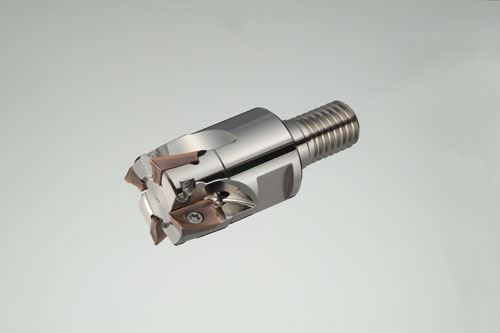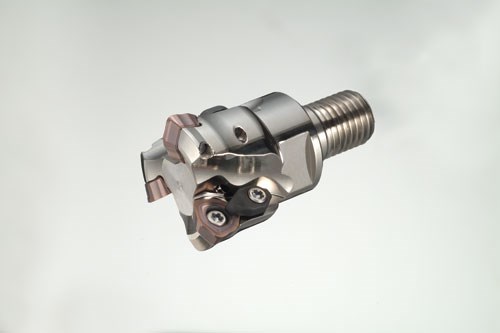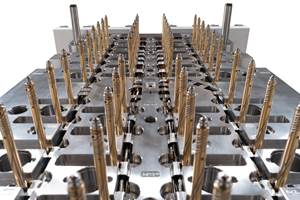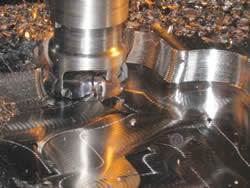End Mills Offer Quality, Accuracy and Affordability
Speed, accuracy and quality are this tool shop's main goals and exchangeable head end mills fulfill those requirements.
Oldenburg Metal Tech (OMT; Port Washington, WI)—a tool and die shop that specializes in mold components, stamping dies, fixtures, complex and precise 3-D machining, general machining and wire EDM since 2005—prides itself on making quality parts with short leadtimes while keeping costs low. A need for accuracy on its strict tolerance work led the company to WRCX exchangeable head end mills, which are part of the Sumitomo modular tool system manufactured by Sumitomo Electric Carbide, Inc. (Mount Prospect, IL).
According to OMT Operations Manager Jeff Decker, the company deals with tight tolerances (.0005”) on a daily basis for its work in diverse industries like automotive, healthcare, lawn and garden, agriculture, recreational vehicles (ATVs and snowmobiles) and appliances. “Accuracy is our main focus so we can cut down on the development time on our tools, and the finish on parts helps keep polishing times down,” Decker says. The exchangeable head end mills offer accuracy, rigidity and the ability for the heads to be quickly changed.
The company began a search for cost-effective, quality end mills to help meet these requirements. “We chose the WRCX exchangeable head end mills because they gave us lower cost, quality tools that helps provide the product we needed,” Decker notes. The fact that these tools are exchangeable allows OMT to use different size heads and different shank lengths—which allows the company to achieve better finishes on parts and greater range of tool use, Decker notes.
“The tools are very versatile,” Decker explains. “They can be used to make deep and shallow cuts. And, the carbide tools are very rigid, which provides less cutter deflection, so accuracy is maintained.”
Sumitomo Sales Engineer Al Grabarczyk notes that stable carbide shank tools reduce chatter and vibration; and carbide shank has less runout over a conventional tool, which results in better overall tool life and less second operation polishing. “The carbide shank also provides long reach for precision, stable milling; and the highly durable cutter bodies are made of alloy steel and protected by a hard surface treatment.”
There are three types of interchangeable head end mills available in this line: a high efficiency end mill, a multi-purpose radius end mill and an ultra-high feed end mill. “The WRCX, which OMT uses, is an excellent durable roughing mill, that has a wide range of applications such as face milling, ramping, slotting, (3-D interpolation mold and die machining) and helical boring,” Grabarczyk states. “The WEX 90-degree style end mill is a good roughing and finishing mill that can pocket, helical bore, slot, shoulder mill and ramp mill. The MSX high-feed milling cutter has air holes that allow for better chip evacuation; and this tool allows the user to take smaller depths-of-cut with much higher feedrates. One can also face, ramp and helical bore with this mill.”
There is a wide variety of possible combinations with carbide or steel arbors (16 carbide items and four steel items), Grabarczyk continues. “With carbide arbor, one can achieve lengths up to 6XD, greater precision, and they are suitable to achieve exceptional finishes.
“The line also offers a full range of carbide inserts for steel, gray cast iron, ductile iron, stainless steel, aluminum, brass and copper, with superior rough and finish milling capabilities,” Grabarczyk adds. Decker notes that OMT has used these tools to cut Ampco bronze and the company was able to achieve a high quality finish on deep cuts with a single pass.
The high-feed tooling reduces run times by increasing OMT’s feedrates, which keep machine hours lower on jobs, Decker says. “These tools are used to take rapid metal removal on parts, so we can get parts out faster and keep our due dates on time,” he stresses. “This product helped reduce costs on our tooling because the rigidity of the tool allows the inserts to last longer, and allow us to pass the savings on to our customer and still be competitive in our industry.”
Decker concludes, “Speed, accuracy and quality are our main goals and these tools fulfill our requirements.”
For More Information:
Sumitomo Electric Carbide, Inc. / (847) 635-0044
a_grabarczyk@sumicarbide.com / sumicarbide.com
Oldenburg Metal Tech / (262) 284-6384
jdecker@oldenburgmetaltech.com / oldenburgmetaltech.com
Related Content
How to Use Scientific Maintenance for More Accurate Mold and Part Troubleshooting
Discover how adopting scientific maintenance approaches helps improve mold lifespan, minimize failures, and optimize production outcomes.
Read MoreWhat is Driving Mold Lifecycle Management Digitalization?
OEMs are looking to partner with suppliers to share and track data across the supply chain for advanced intervention and process management.
Read MoreHow to Solve Hot Runner Challenges When Molding with Bioresins
A review of the considerations and adaptations required to design hot runners and implement highly productive injection molding operations.
Read MoreDynamic Tool Corporation – Creating the Team to Move Moldmaking Into the Future
For 40+ years, Dynamic Tool Corp. has offered precision tooling, emphasizing education, mentoring and innovation. The company is committed to excellence, integrity, safety and customer service, as well as inspiring growth and quality in manufacturing.
Read MoreRead Next
Cutting Tool Slashes Cycle Times by 75 Percent
This moldmaker reduces cycle times from 10 hours to two hours with a more durable, faster cutter that also leaves a nice finish.
Read MoreHow to Use Continuing Education to Remain Competitive in Moldmaking
Continued training helps moldmakers make tooling decisions and properly use the latest cutting tool to efficiently machine high-quality molds.
Read MoreReasons to Use Fiber Lasers for Mold Cleaning
Fiber lasers offer a simplicity, speed, control and portability, minimizing mold cleaning risks.
Read More






.png;maxWidth=300;quality=90)


















